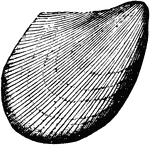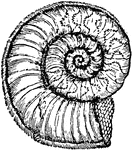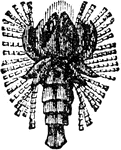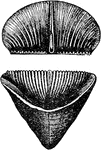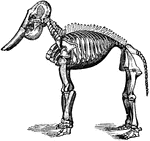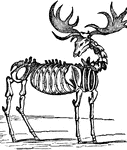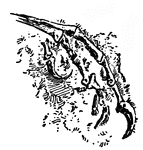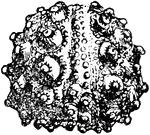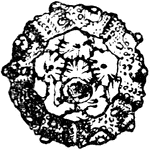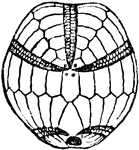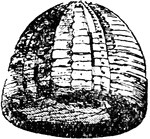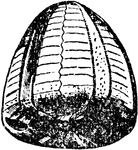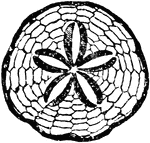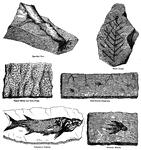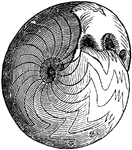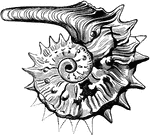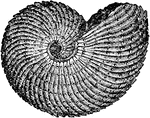
Ammon's Horn (Shell)
An illustration of an Ammon's Horn shell, a fossil shell, curved like a ram's horn. A name previously…
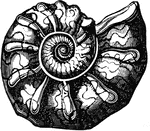
Ammonite
"They were of various forms, but they were of carnivorous habits, resembling the speias, and, like the…

Ammonite
"Ammonite is the name for a large genus of fossil chambered shells."—(Charles Leonard-Stuart,…
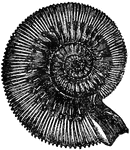
Ammonite
"Ammonite is the name for a large genus of fossil chambered shells."—(Charles Leonard-Stuart,…

Ancyloceras
"A genus of fossil terebranchiate cephalopods, of the family Ammonitidæ, or made the type of a…
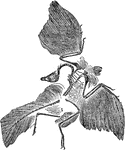
Archaeopteryx Fossil
An illustration of the skeletal fossil of Archaeopteryx, the earliest and most primitive bird known.…

Pacops Articulate
An ancient articulate from the Paleozoic time, Pacops bufo from the Hamilton group.
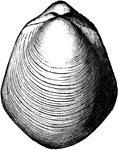
Pentamerus Brachiopod
A mollusk radiate from the Paleozoic time, Pentamerus oblongus, a brachiopod from the Clinton group.

Footprint of brontozoum giganteum
A footprint of brontozoum giganeum, a now extinct relative of the cassowary. This example is eighteen…

Calymene
"The trilobite's general form is shown in the annexed figure of the Calymene Blumenbachii;…
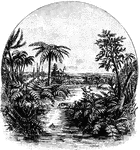
Carboniferous Landscape
The continents during this age consisted mainly of large, flat, marshy areas, covered with luxuriant…

Chirotherium Tracks
An illustration of a fossil containing Chirotherium tracks. Chirotherium (also known as Cheirotherium)…
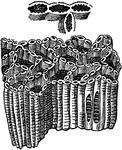
Chain Coral
The chain coral. This is an important index fossil of the Silurian, and an important limestone builder…
Diplodocus
An illustration of a Diplodocus skeleton and the caudal vertebrae (A and B). Diplodocus is a genus of…
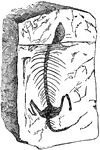
Fossil
This illustration shows the ancient fossile of an amphibian. Fossils are the mineralized or otherwise…
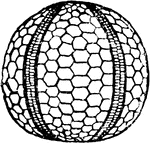
Fossil Echinidea
"Palaechinus sphaericus, Scouler; Carbouiferous, Ireland." — Encyclopedia Britannica, 1893

Fossil Echinidea
"Archaeocidaris Urii, Flem (spine and intermediate plate); Carboniferous, Ireland." — Encyclopedia…

Fossil Echinidea
"Cidaris glandifera, Goldf (spine); Jura, Mount Carmel." — Encyclopedia Britannica, 1893
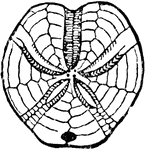
Fossil Echinidea
"Hemipneustes Greenovii, Forbes, U. Greensand, Blackdown" — Encyclopedia Britannica, 1893

Fossil Echinidea
"Cidaris florigemma, with spine, a, and single ambulacral plate, magnified, b, (after Wright; Coral…
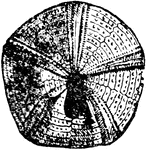
Fossil Echinidea
"Pygaster semisulcatus, Ph.; Inf. Oolite, Cheltenham." — Encyclopedia Britannica, 1893
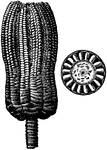
Fossil Encrinite
When the remains of an animal or plant are exposed to the air or buried in dry earth, they generally…

Glyptodon
"Glyptodon (Glyptodon clavipes). The typical and best-known genus of the family Glyptodontidae; the…

Graptolites in Stone
"Block of Stone containing Graptolites. GRAPTOLITE. A specimen or a species of Paleozoic coelenterate…

Holoptychius
"A fish known chiefly by scales, fossil remains of which are found in Old Red Sandstone." — Williams,…
Archaeopteryx Skeleton
An illustration of an Ichthyosaurus skeleton. Ichthyosaurus is an extinct genus of ichthyosaur from…

Leaf Indentations
An illustration of a fossil of a toothed fern. Ferns are vascular plants differing from the more primitive…

Lingula Antigua
The Lingula antigua is a little bivalve shell belonging at the bottom of the class Brachiopoda. The…
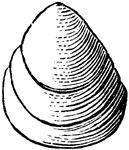
Lingula Prima
The Lingula prima is a little bivalve shell belonging at the bottom of the class Brachiopoda. The inarticulate…
